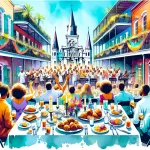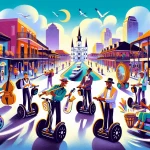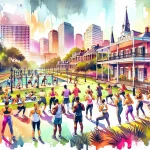The French Quarter Festival is a beloved annual celebration that takes over the heart of New Orleans every spring. This four-day extravaganza immerses visitors in the city’s music scene, culinary delights, and cultural heritage, providing a feast for the senses.
In This Article
TL;DR
- The festival showcases an array of live music performances, featuring local artists across genres like jazz, blues, zydeco, and brass bands.
- Over 75 food and beverage vendors serve iconic New Orleans dishes, from po’boys and gumbo to innovative fusion creations.
- Beyond music and food, the festival offers unique street performances, entertainment, and insights into the city’s rich cultural legacy.
Planning Your Visit
Choosing the Right Time to Go
The French Quarter Festival typically takes place in mid-April, when New Orleans experiences pleasantly warm weather, with temperatures ranging from the mid-60s to the low 80s. This time of year offers an ideal balance between the cooler winter months and the sweltering summer heat, making it perfect for exploring the festival’s outdoor offerings.
While the festival spans four days, certain days and times may be more crowded than others. Weekends tend to be busier, with larger crowds and longer lines for food and drinks. For a more relaxed atmosphere, consider visiting during the weekdays or earlier in the day.
Accommodation Tips
To fully immerse yourself in the festival experience, consider staying within or near the French Quarter. This historic neighborhood is the heart of the festival, with stages and vendors lining its iconic streets. Booking accommodations in the French Quarter or nearby areas like the Marigny or Treme neighborhoods will allow you to easily walk to and from the festival grounds.
For a more budget-friendly option, consider staying in the Central Business District or the Garden District, both of which offer easy access to the French Quarter via public transportation or a short ride-share trip.
To secure the best deals on accommodations, plan your visit well in advance. Many hotels and vacation rentals offer discounted rates for early bookings, so it’s wise to reserve your accommodations several months in advance, especially during the peak festival season.
Navigating the Festival
With over 20 stages and countless food vendors scattered throughout the French Quarter, navigating the festival can be a challenge, especially for first-time visitors. To make the most of your experience, familiarize yourself with the festival map and plan your route accordingly.
Public transportation is an excellent option for getting to and from the festival. The historic St. Charles Avenue streetcar line runs directly to the French Quarter, offering a scenic and convenient way to travel. Alternatively, you can take advantage of the city’s ride-share services or park in one of the nearby garages or lots.
Once you’re in the French Quarter, be prepared to do a lot of walking. Comfortable shoes are a must, as you’ll be exploring the festival’s various stages and vendors on foot. If you need a break, consider renting a pedicab or taking advantage of the festival’s shuttle service, which operates between key locations.
Music and Entertainment
Discovering the Music Scene
The French Quarter Festival is a true celebration of New Orleans’ rich musical heritage, showcasing a variety of genres and artists. From the soulful melodies of jazz and blues to the infectious rhythms of zydeco and brass bands, the festival’s stages offer a captivating journey through the city’s musical landscape.
While the festival features well-known local acts, it’s also an excellent opportunity to discover up-and-coming artists. Keep an eye out for smaller stages and intimate venues, where you may stumble upon the next big name in New Orleans music.
To make the most of your musical experience, consult the festival’s schedule and plan your days accordingly. Prioritize the artists and genres that interest you most, but also leave room for spontaneous discoveries and unexpected delights.
Street Performances and Other Entertainment
Beyond the main stages, the French Quarter Festival offers a vibrant array of street performances and entertainment. Strolling through the historic streets, you’ll encounter everything from mesmerizing fire dancers and acrobats to talented street musicians and living statues.
Take the time to explore the festival’s various entertainment offerings, as they provide a unique glimpse into the city’s rich cultural tapestry. Whether you’re captivated by a lively second-line parade or enthralled by a skilled tarot card reader, these experiences will add depth and authenticity to your festival adventure.
Culinary Delights
Sampling Local Cuisine
One of the highlights of the French Quarter Festival is the opportunity to indulge in New Orleans’ renowned culinary scene. With over 75 food and beverage vendors, the festival offers a tantalizing array of local dishes, from classic Creole and Cajun fare to innovative fusion creations.
Be sure to sample some of the city’s iconic dishes, such as the mouthwatering po’boy sandwiches, savory gumbo, and decadent beignets. For a true taste of New Orleans, seek out vendors offering dishes like crawfish étouffée, jambalaya, and muffulettas.
While the food stalls offer a convenient and affordable way to sample local cuisine, don’t overlook the opportunity to dine at some of the French Quarter’s renowned restaurants. Many establishments offer special festival menus or outdoor seating areas, allowing you to enjoy a more leisurely dining experience while soaking in the festival atmosphere.
Food and Drink Tips
With so many tempting options, it can be easy to overindulge at the French Quarter Festival. To avoid long lines and high prices, consider visiting food vendors during off-peak hours, such as early afternoon or late evening.
If you have dietary restrictions or preferences, don’t worry – the festival offers a diverse range of options to accommodate various needs. Look for vendors offering vegetarian, vegan, or gluten-free options, and don’t hesitate to ask about ingredients or preparation methods.
Remember to stay hydrated, especially if you plan on indulging in the festival’s adult beverages. In addition to water, consider trying refreshing local drinks like frozen daiquiris or the iconic Hurricane cocktail.
Cultural and Historical Insights
The Festival’s Impact on New Orleans
The French Quarter Festival is more than just a celebration of music and food; it’s a testament to the resilience and vibrancy of New Orleans’ cultural heritage. The festival has played a significant role in preserving and promoting the city’s unique traditions, while also providing a much-needed economic boost for local businesses and artists.
Speak with local business owners and artists to gain insights into the festival’s impact on their livelihoods and the community as a whole. You’ll likely hear stories of how the festival has helped sustain the city’s cultural legacy and provided a platform for emerging talents to showcase their skills.
Historical Perspectives
To truly appreciate the French Quarter Festival, it’s essential to understand its historical context. The festival’s origins can be traced back to the revitalization efforts of the 1980s, when the city sought to breathe new life into the historic French Quarter after a period of decline.
Over the years, the festival has evolved and grown, reflecting the changing cultural landscape of New Orleans. From its humble beginnings as a one-time event to its current status as a beloved annual tradition, the French Quarter Festival has become an integral part of the city’s identity.
Explore the festival’s history by visiting the Old U.S. Mint, which often hosts exhibits and displays related to the event’s past. You may also encounter local historians or tour guides who can share fascinating stories and insights into the festival’s evolution.
Practical Tips for Festival-Goers
What to Bring
To ensure a comfortable and enjoyable experience at the French Quarter Festival, it’s essential to come prepared. Pack a small backpack or cross-body bag with essentials like sunscreen, a portable charger for your phone, and a refillable water bottle.
Comfortable walking shoes are a must, as you’ll be spending a significant amount of time on your feet. Consider bringing a lightweight, breathable hat or visor to protect yourself from the sun, and don’t forget a portable fan or misting bottle to stay cool in the warm spring weather.
If you plan on purchasing souvenirs or indulging in local cuisine, bring a small cooler or insulated bag to transport your purchases and keep perishable items fresh.
Staying Connected
In the age of smartphones and social media, staying connected during the festival is easier than ever. Many areas within the French Quarter offer free public Wi-Fi, allowing you to share your experiences and access festival information on the go.
If you’re concerned about your phone’s battery life, consider bringing a portable charger or locating one of the festival’s mobile charging stations. These convenient stations allow you to recharge your devices while enjoying the festivities.
Additionally, the French Quarter Festival has its own mobile app, which provides up-to-date information on schedules, vendor locations, and other essential details. Download the app before your visit to ensure you have all the necessary information at your fingertips.
Beyond the Festival
Exploring the French Quarter
While the French Quarter Festival is undoubtedly the main attraction, the historic neighborhood itself offers a wealth of experiences to explore. Take advantage of the festival’s downtime to wander through the charming streets, admiring the iconic architecture and soaking in the vibrant atmosphere.
Consider taking a guided tour to learn about the French Quarter’s rich history and uncover its hidden gems. From tours that delve into the area’s spooky past to culinary tours that showcase the best local eateries, there’s an option to suit every interest.
Alternatively, you can embark on a self-guided exploration, allowing you to discover the French Quarter at your own pace. Stroll along Royal Street, browsing the eclectic shops and galleries, or visit iconic landmarks like St. Louis Cathedral and Jackson Square.
Day Trips and Nearby Attractions
If you have extra time before or after the French Quarter Festival, consider venturing beyond the city limits to explore the surrounding areas. New Orleans and its surrounding regions offer a wealth of attractions and experiences that complement your festival adventure.
For a taste of Louisiana’s natural beauty, take a day trip to the nearby swamps and bayous. Guided tours offer the opportunity to spot alligators, turtles, and a variety of bird species in their natural habitats, while also providing insights into the region’s unique ecosystem.
History buffs may enjoy visiting nearby plantations, such as Oak Alley or Laura Plantation, where you can step back in time and learn about the state’s complex past and cultural influences.
Alternatively, consider a day trip to the charming town of Abita Springs, known for its craft breweries and picturesque scenery, or explore the vibrant art scene of St. Tammany Parish, just across Lake Pontchartrain.
By combining the French Quarter Festival with these additional experiences, you’ll gain a deeper appreciation for the rich tapestry of New Orleans and its surrounding regions.






